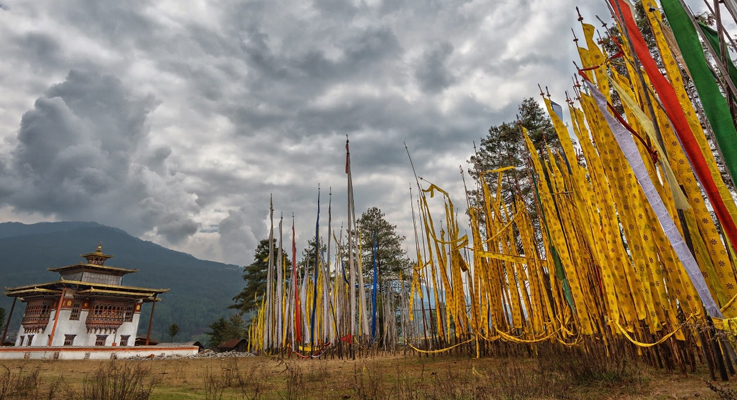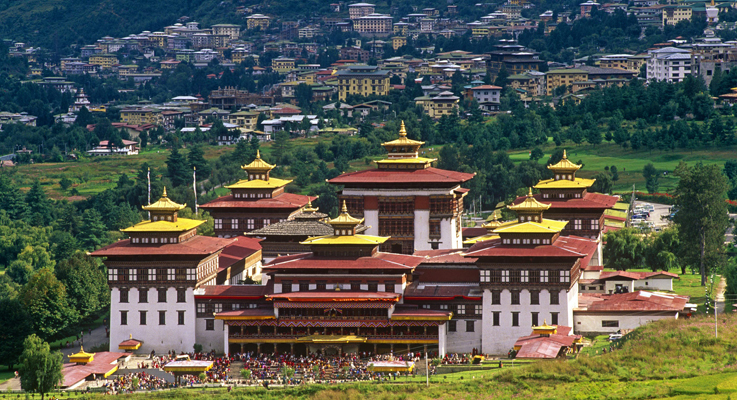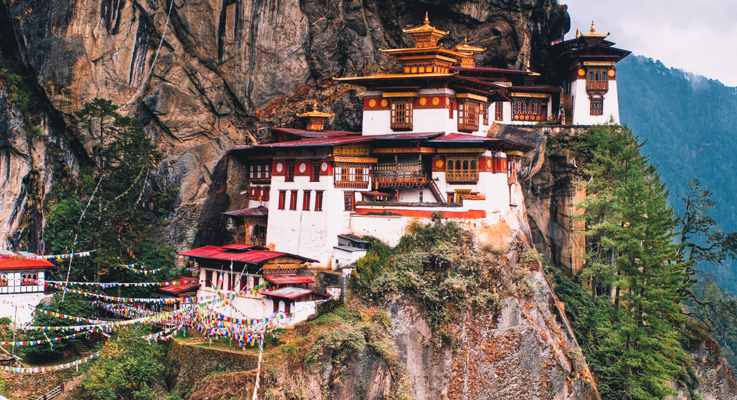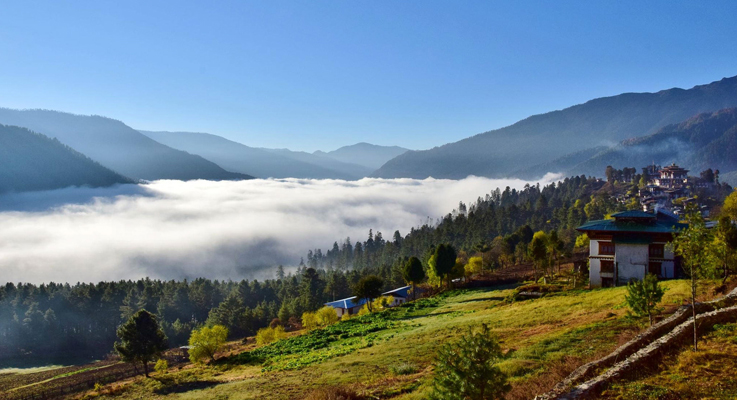-
Day 1
Fly from Kathmandu to Paro
The flight into the Bhutan Himalayas is one of the most spectacular experiences you will ever have. Flying in from the sweltering heat of the plains of India towards the North East, one can witness from the left side of the plane, a chain of the World's highest and majestic peaks. Pay careful attention when the Druk Air captain points out the names: Mt. Everest, Lhotse, Mt. Makalu, Kanchenjunga and the rest as you fly pass then in minutes. Soon you will descend into Druk Yul, and even as the plane lowers it landing gears preparing for landing you will not find any airstrip or signs of a city, do not despair, instead enjoy the view of the approaching valley and the primeval alpine forests, the little monasteries, temples and farm houses all in splendid isolation. Moments before landing, you may catch a glimpse of the fertile Paro valley, the colossal Paro Dzong and the winding Paro Chu river. As you step out of the plan, take your first breath of cool, clean fresh air, this will be your first free gift Bhutan has to offer to all its guest. After your Bhutanese guide identifies you, be will escort you to the Olathang Hotel on the hill.
-
Day 2
Paro Valley
The people of Paro are known for their hard work, which they like to show in their big and traditional country houses. If you marry a girl from Paro, be prepared to put metal roofing over the traditional shingle roof in your wife's house, to show that you are a capable and well-to-do husband, so we joke among ourselves. Morning sightseeing includes: The Ta Dzong National Museum considered to be one of the best natural and historic artifact: the majestic Jumolhari or the "Mountain of the Goddess" can be seen in the background many, the 2-3 hours hike to Taktsang or the famous "Tiger's Nest" is a memorable spiritual journey. It was here that the great tantric master Guru Padmasambhava flew in from Tibet on a tiger to bring Buddhist teachings to Bhutan, since then may Buddhist master have made this an important retreat in their spiritual quest; the remainder of the day can be spent shopping or simply strolling through town.
-
Day 3
Thimpu: The capital of Bhutan
Thimphu is a short hour and half drive from one main valley to the next across paddy fields, apple orchards, farmhouses, cattle and cowboys, pine trees and hamlets that smell of burning wood. Check in at the Etho Metho Cottage, the Jumolhari or Druk Hotels. When in Thimphu be prepared for several things. This unique capital (8000ft.) of the kingdom has adopted its own version of the British-India colonial times traffic policemen, who can startle you and memorize others with his elaborate hand gestures: sometimes he may be signaling stop whine it looks like go but don't worry just observe the flow abed notice his smile as you stare at time.
Afternoon sightseeing includes the Tashichhodzong, seat of the Royal Government and central monastic body, it was rebuilt in the early 1960s after a fire destroyed most of the building: the late King's Memorial Chorten which is well visited by the residents of Thimphu during festive and religious occasion; late afternoon stroll through town; not far from the market place is the Changlimithang grugh where you will always find the game of archery (the national sport of Bhutan) being played: there will be time of shopping and looking around by you self on the return journey from Bumthang.
-
DAY 4
Thimpu to Gangtey via Punakha and Wangdi
After breakfast, drive east climbing steadily towards the Dochu La pass at 10,000ft. A large chorten and a forest of prayer flags greet you as you face the range of majestic peaks towards the North, Gangar Punsum, among others is the highest unclimbed peak (over 24,000ft.) in the world. The descent from the pass through temperate forests colored with rhododendrons and magnolias, down to the semitropical zone of orange, banana and cactuses. Situated near the river on a small plateau is the famous Chime Lhakhang built by famous "divine mad monk" Drukpa Kunley, a famous pilgrim site for infertile women who wish to bear children.
The Punakha Dzong built in the 16th Century was the Winter capital for 300 years; today it is winter home to the Je Khempo the Chief Abbot, hundreds of monks and also serves as the administrative headquarters for the Punakha district. Downstream from the Punakha valley is the Wangdiphodrang Dzong strategically located on a ridge (at 4430ft.) overlooking the old trade routes that ran east west and north south. The Punakha and Wangdi valley are also the winter home for many of the high altitude farmers who migrate with their cattle to the warm climate in the valley.
The numerous paddy fields indicate the ideal conditions for agriculture, farmers here often grow 2 to 3 crops a year, rice and chili being important cash crops for the farmers. Stop for picnic lunch at the Wangdi guesthouse.
After lunch, about 3 hours drive to one of the most beautiful open valleys in Bhutan, Gantey is winter home to the rare and endangered black necked cranes which migrate to Bhutan around mid November from Tibet and central and eastern, Sikang, Yunnan and Tonkin in China. Cranes have for centuries captured the human imagination with their intelligence, poise, sociality, beauty and freedom, and have given rise to several myths, legends, folktales and songs. The Bhutanese have their songs of the crane popular among village folks. This year (1993) about 180 birds have arrived from Tibet to feed in their traditional habitats in Gantey. By mid February, the cranes fly back across the Himalayas to their summer home towards Tibet and China. The small village is dominated by the yellow roofed Gangtey Monastery, said to be the only Nyingmapa monastery in Bhutan headed by the Gantey tulku (ninth reincarnation to bear the name). Overnight stop at Etho Metho Lodge in Gantey in the vicinity of the monastery.
-
Day 5
Gangtey to Jakar
For the bird enthusiasts an early morning excursion to view the cranes cab be arranged. After breakfast, continue journey towards the Pela La Pass crossing the Black Mountains which divide western and central Bhutan, takes about 4-5 hours, magnolias and rhododendron among grazing yaks are memorable sites along the pass; on clear days the Jumolhari can be seen at 23,685ft, towards the west. After passing through the domain of Yak, sheep and short bamboo brush, past the Nikkarchu Bridge is the Tongsa district; the great white washed stone chorten, built in Nepalese style in the 18th century lies on a bend below the road. A Lama called Shida who subdued a demon that was a menace to the valley founded the temple.
As you approach Tongsa, you cannot miss viewing the "never reaching" Tongsa Dzong in the distance, visible yet elusive before you actually get near it. Stop for lunch at the Tongsa Lodge or one of the comfortable wayside inns run by Tibetan residents. Commanding the Mangde rive valley at an altitude of 2,200m (7220ft) Tongsa Dzong is the most impressive Dzong of Bhutan.
It used to be the old gateway between the east the west. The Dzong built in 1647 by Shabdrung Ngawang Namgyel is a masterp8ece in architecture that includes countless courtyards, passageways and corridors, in addition to the 23 temples inside the Dzong. After lunch is a short 2-3 hrs. Drive to Bumthang. Overnight halt at Jakar Lodge.
-
Day 6-7
Bumthang
Different from all the other valleys in Bhutan is the spacious and open valley of Bumthang: ranging in altitude from 2600m (8530ft) to 4000 (13,125ft), Bumthang is a heaven for trekkers and hikers, not to mention the numerous beautiful and important Buddhist monasteries and pilgrimage sites, making it the cultural and historic center of Bhutan. One could spend months exploring this fascinating valley. Almost beautiful and important Buddhist monasteries and pilgrimage sites, making it the cultural and historic center of Bhutan. One could spend months exploring this fascinating valley. Almost every little valley or a hill has a background of interesting myths and legends about kings, Buddhist masters, and serpents. Bumthang is especially dotted with the religious relics left by the famous Guru Rinpoche, and his reincarnati9on the Treasure Finder, Terton Pemalingpa who is known to have found the scared Buddhist Texts after diving into a lake (Membertsho lake / pool) with a lighted lamp on his head among the many sightseeing places are the Jakar Dzong, the Dzong funded by a white bird; the Jambe and Tamshing Lhakhang where the kings of Bhutan are taken for their cremation rites; besides the religious sites do not miss a trip to the famous Bumthang Matha regions (villages) where you can find rich woolen plaid textiles dyed with natural colors, and the Yatas, a thin woolen cloth with bright patterns often make into warm jackets and scarves.
-
Day 8
Bumthang to Wangdiphodrang
-
Day 9
Wangdiphodrang to Thimpu
This last day of your journey can be spent relaxing in your hotel/lodge, or simply touring the vicinity of Thimphu, shopping, meeting your travel agents and friends; evening you have a choice to travel over to Paro for the night or stay back in Thimphu.
-
Day 10
Thimpu to Paro. Departure from Bhutan
Good Bye! And happy journey back home.




